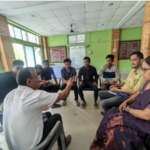BANANI DAS CHOWDHURY talks about the paradigm shift which has taken place in the sphere of social communication and how it affected the youths the most.
Our urge to communicate and live in a social environment is as old as the history of mankind. With time, our modes of communication changes and technology added more sparks to it. This is the age of clicks and tweets. As the Magi (wise people) gifted new born Jesus three gifts, namely gold, frankincense and myrrh; gold symbolizing as valuable, frankincense as prayer, myrrh as sufferings (according to the internet sources) so also we are gifted by the wise technologhy with the gifts of new means of communicating socially, through social media sites viz Facebook, Twitter, We Chat, Blogs, Myspace, You Tube, Whatsapp, Hike and the list goes on. In this busy life, everyone, especially, the youths and the teenagers are religiously, valuably communicating socially yet not left out from the suffering sides of it which can be vulnerable in leading the young generation astray and undermine their social traits and personality.
Social media is free, available 24*7 and instant, within our pocket’s reach. Ishita, a vivid netizen and a media professional exclaims, “Being one from the Gen Y, I like to be socially active through these social sites, connect with friends, share, update in this busy schedule of life. It satisfies our social craving.” Virtual social interactions rules most of our daily dose of communication. Sarbani, a B Tech student feels, “Most of us are becoming addicted to it, which distracts us from our goal.” Updating pictures, comments, status has become a matter of self obssesion. But do we communicate what we are truly, to our connections on the web? In this context, Hrithik studying media research adds, “We like to portray good about us and nothing bad. It’s ironical indeed.”
Virtual social media lacks what is in face to face communication. Ms. Shelly, Lecturer, at a reputed college and a writer, enlightened her thoughts on this, “Call it a generation gap in my thinking, but I personally feel virtual social communication lacks personal touch, whereas face to face communication with body language gestures makes the communication more lively”. Virtuality cannot be a substitute for reality. We are getting disconnected though connected.
But we cannot rule out its positive sides. Social media also gives us a platform in the form of blogging, You Tube, Flickr etc to communicate socially our talents to a larger audience. It’s informative also. Deepika, a Counsellor of a reputed educational organisation exerts, “In social media, information spreads in bullet’s speed. We youngsters get to know and disseminate various experiences.” Yes, we can exercise our right to freedom of speech; share our voices on various issues of the society.
Social networking also gives the oppotunity to make new friends, reconnect with old ones, keep in touch with the relatives residing far and aboard, cheaper than the STD, ISD phone bills. Also these are the hot hunting spots for finding one’s soul mates. Relationships and marriages are a few clicks and chats away. Talking about online relationships, Nitika, an aspiring lawyer, recollects, “During my practical classes at law, I found a case, where a girl, married to a boy getting to know from online chatting, later found, who was already married with two kids, and this is not a single instance, there are a lot of cases like this.”
With everything a few clicks away, teenagers, youths, gets carried away by the lure to get noticed, upload and download to one’s heart’s content. The menace of cyber crime, cyber stalking, MMS scandals, pornography etc are on a rise. TV Shows like Gumrah, MTV Webbed etc. enlightens us that how the Gen Y are leading astray using some means of these social communications. Whereas, Tomal, teaching computers in a reputed educational organisation, argues, “We like to be online, and some are misusing it though, but still different factors play part in a youth’s mental set up, online social communication is not alone to be blamed.”
Answering on this innovative trend in youth’s social communication culture, whether it’s a boon or bane, Mr.Abhijit, a retired Professor, of a reputed college, puts, “It has both good and bad sides. Completely a matter of debate”.
It is debatable indeed, every coin has two sides. With passaage of time, changes would take place, reshaping our culture and communication. What we can do is to nurture the good and do away with the bad. Our modes to communicate socially are in our hand and handling it with utmost responsibility both online and offline is important. And equally important is to retain and cultivate our moral and cultural values.







